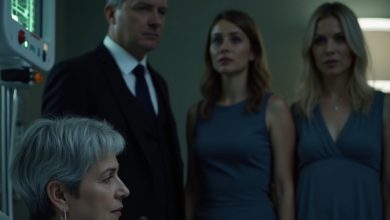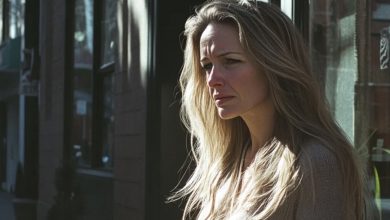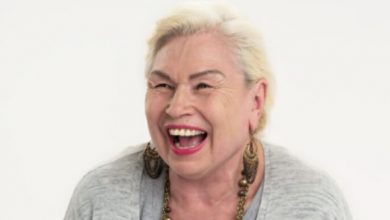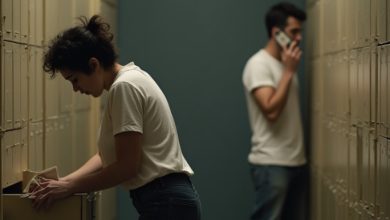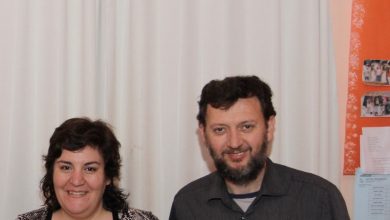The child who never spoke let out a scream at his grandmother’s funeral—and his words shocked every person there.
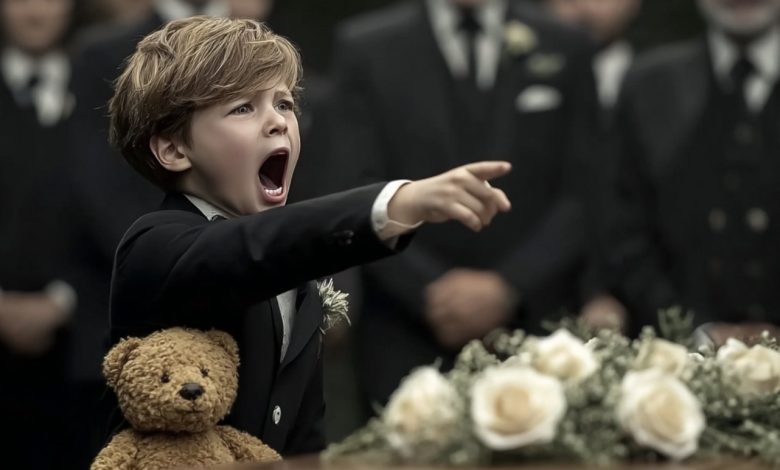
A cold breeze drifted through Oakwood Cemetery the day Mary Dawson was finally laid to rest. Everyone who loved her stood in hushed tribute: neighbors, friends, and family gathered around the open grave. Mary, the unwavering heart of her household, had always been the one to bring people together, so her passing felt like a light going out. As her coffin was slowly lowered, the mournful notes of the funeral bell seemed to echo forever—until a sudden, piercing cry cut through the quiet. It came from six-year-old Michael, Mary’s grandson, a child who up to that moment had never spoken a single word.
No one could believe their ears. Michael trembled in his mother Clara’s arms, his small body shaking, before he let out a scream that stopped the service in its tracks. The hush turned into stunned silence. Heads whipped around; tears froze on cheeks. A boy who was known to be mute had just shouted. Even more shocking were the next words that spilled from his lips—words so clear and devastating they threatened to tear his family apart and draw the whole town into a painful search for the truth.
A Family Wrapped in Grief—and Growing Doubt
From the moment Mary’s body was found at the bottom of her stairs, her death had been labeled a tragic accident. The police had concluded she slipped, falling headfirst, her wrist at an odd angle. Blood had pooled beneath her, and neighbors whispered of how sudden it had all been. Clara refused to rest easily, though. In the days before her mother died, Mary had been restless—changing passwords on her safe, updating her will, and warning Clara in hushed tones, “If anything ever seems wrong, remember that appearances can lie.”
On the morning of the funeral, Clara knelt beside her boy. Her fingers gripped his little shoulders as if she could hold on to him and keep him safe from whatever storm was about to hit. Jason, Mary’s only son and Clara’s brother, stood a few steps away—stoic, almost cold. His eyes never welled with tears and his arms remained folded. Some family friends noticed it and felt a prick of unease. Why did Jason seem so indifferent? Looking back, it was a clue none of them understood until much later.
The Outburst That Tore Through Silence
As the priest began his final words, a shovel scraped the earth. Everyone watched the coffin sink. Then Michael stiffened. His eyes opened wide, and he screamed:
“He pushed Grandma down the steps! I saw him do it!”
Gasps roared through the crowd. The priest’s hand froze mid-gesture. Clara’s breath caught in her throat. Jason snapped his head around, shock painting his face pale. Neighbors clutched each other. The recording on Mrs. Carol’s phone was still rolling—every moment captured. Some whispered, “My God, the boy just talked!” Others shouted, “But he’s always been mute!” Clara gathered Michael to her chest, tears streaming, not from grief but from bewilderment and fear. The stunned guests watched her, realizing in that heartbeat that nothing would ever be the same.
Gathering Pieces of a Hidden Puzzle
The next day, Clara awoke exhausted, her heart pounding. Michael’s words replayed in her mind. Soon, Mrs. Carol and her husband, Dr. Richard, came by with startling news rather than comfort. They handed over Mary’s autopsy report. A fall, the coroner had initially said—yet a closer look showed Mary’s wrist had been bent in a way that didn’t match a simple slip. A faint bruise on her neck hinted someone might have grabbed her. The couple also shared what they had seen: Jason leaving his mother’s house at dawn the day she died, his eyes red, not from tears but from something more troubling.
Clara forced herself to remember that morning exactly. Michael had woken her, shivering, pointing at the top of the staircase with a look of terror on his face. Jason claimed he only arrived when Clara called him, but Mrs. Carol’s testimony suggested otherwise. Confusion turned into dread as Clara realized she needed to go to the police.
The Police Take Notice
Inspector Lucas Mitchell greeted Clara at the station. She laid out every detail—Mary’s warnings, the odd bruise, Jason’s strange behavior, and the phone video from the funeral. Mitchell was skeptical at first. A mute child suddenly speaking at a funeral? Unlikely evidence. But when he learned Michael’s muteness had no physical cause—psychologists agreed it was trauma-induced—he changed his approach. He took the funeral video and promised to treat every line of it as evidence.
Armed with Clara’s testimony, the autopsy, and the video, Mitchell ordered a look at the Dawson home security system. The night Mary died, footage should have shown everything. Instead, the files had been wiped clean. That only fueled his suspicions.
Recovering the Sounds of a Crime
Enter Ethan, a young technician with a gift for pulling lost data from digital rubble. He worked late into the night, finally unearthing an audio clip. It began with Mary’s calm but firm voice: “Clara is my daughter. She gets everything.” Then came Jason’s low, trembling reply, laced with anger. The recording caught their voices rising, footsteps pounding on hardwood, Mary’s gasp, and then a sickening crash. Silence followed.
That clip changed everything. It proved a struggle, a moment of violence. The very next morning, Jason had accessed the security system, deleting footage as if he knew it would incriminate him.
Motive and Opportunity
With audio in hand, police searched Jason’s apartment and found a hidden USB drive. Inside lay a notebook filled with numbers—debts far larger than anyone knew. Jason’s mounting bills gave him a desperate motive: Mary’s life insurance and assets. He was the only other heir. Clara, who would stand to receive her mother’s estate according to Mary’s rewritten will, was suddenly in danger of losing everything if Jason’s plan had succeeded without blowback.
Meanwhile, Michael returned to his world of silence, nearly catatonic. Yet in his quiet, he emptied his feelings into drawings: a tall, bent over grandmother; a man raising his arm above her; a staircase dripping with darkness; a small child clutching a bear. Each sheet matched the autopsy and the recordings.
Turning Evidence into a Case
Clara pressed the police to move fast. Oakwood buzzed with rumors, and the video of Michael’s outburst at the funeral spread across phones and social media. Some viewers called it “miraculous proof.” Others insisted “kids can’t mimic things they haven’t seen.” With every piece—audio, drawings, eyewitness accounts, security logs—Chief Mitchell assembled a case.
The final blow came when a brief clip surfaced showing Jason stepping out of Mary’s house at 4:07 a.m., blood spattering his sleeve. That solitary frame, timestamped and clear, sealed the authorities’ need to act.
A Trial That Laid Secrets Bare
In the courtroom, Jason’s defense tried to discredit every element. They argued a traumatized child might blur truth and fantasy. But the prosecution played Mary’s voice on the tape, showed Michael’s stark drawings, and displayed security timestamps. They called Mrs. Carol and Dr. Richard to testify about Jason’s movements. They even presented text messages where Jason had tried to learn how to erase digital files without detection.
After days of deliberation, the jury found Jason guilty of murder, tampering with evidence, and obstructing justice. The judge pronounced a life sentence without parole. Jason’s face remained impassive as the gavel fell, the courtroom silent but for Clara’s soft sobs.
From Silence to Healing
For Clara and Michael, the verdict brought some relief but also the hard work of healing. Under the care of Dr. Laura Matthews, the boy’s inner voice found its way back. At first, he spoke a single, trembling word. Within weeks, he pieced together sentences. His drawings shifted tone, from dark scenes of violence to sunlight-filled kitchens and happy family gatherings.
Clara used her mother’s estate to honor Mary’s legacy. She launched the Mary Dawson Scholarship Fund, which gives financial help to children recovering from trauma. The scholarship’s first recipients were two siblings who had lost their parents in a car crash—kids whose pain mirrored Michael’s early struggles.
A New Beginning at the Family Bakery
The bakery that Mary had owned stood shuttered for months after her death. It had once been the town’s gathering place, the site of birthdays, holidays, and everyday chats over coffee and cinnamon rolls. Clara reopened it with her son by her side. On opening day, she placed Michael on a small stool behind the counter and invited him to say a few words.
His voice rang clear: “I miss Grandma, but I know she wants us to smile again.” The room erupted in applause. The smell of fresh bread and cocoa warmed the old brick walls. Clara caught her son’s eye and saw in his smile the spark of hope Mary would have loved.
The Lasting Power of Truth
Michael’s journey—from a child trapped in silence to the brave witness who spoke out—became a symbol for Oakwood. Local news stations covered his story, and Clara spoke at schools about why adults must listen to children, especially when they try to tell hard truths.
Even Jason, behind bars, sent a letter. He admitted his guilt and asked that whatever money he still had go to the scholarship fund. “Michael,” he wrote, “did what I never could—face the truth.” His words brought a bittersweet close to the chapter, a sign that even in remorse there can be some small good.
Clara saved that letter in a box with Mary’s old recipes and Michael’s early drawings. Each item reminded her that love, courage, and honesty can break through the deepest silence. In Oakwood, people still whisper about the small boy whose voice was the key to justice—and a brighter future for everyone who believed in him.

